Bachmann On30 2-6-0 DC to DCC Sound
Posted
#264396
(In Topic #14390)
Full Member
On30 narrow gauge set in the Appalachian Plateau circa 1912
Hi All,This is a project that has been lying on the storage shelf for some 2+ years. I bought a s/h Bachmann On30 PRR passenger train set for a song ($60) 3 years ago, I more than recuperated the cost by selling the passenger cars and track. I was left with a 2-6-0 engine and tender that by the look of the wheels had had seen very little running. It ran very smoothly with DC, the aim was to convert to DCC and sell in time for Christmas. COVID-19 and its consequences got in the way, so there it sat. The latest layout I am slowly building, the OR&WRR circa 1912, needs a couple of 2-6-0 locomotives, so off the shelf it came and onto the workbench. My notes at the time had identified some minor issues, consulting some references on the prototypes indicated a few more. Time to have a look to see where I had reached with the conversion, and to order any bits that would be required.
Disassembled engine and tender.
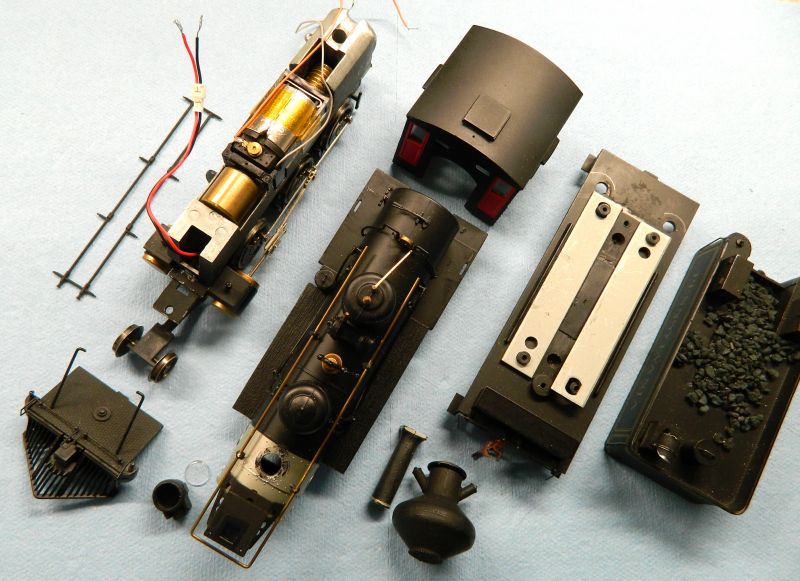
Good news is that it's all there, including a bag of screws. I had removed the smoke generator, located where the pickup wires come up at the front of the chassis, and removed, insulated and rewired the motor with grey and orange DCC wires. It has a large 5-pole motor with an impressive flywheel. I'd also removed some metal at the rear of the chassis to accommodate the wires to and from the tender, where I intended to locate the decoder and speaker. It has 2 chimneys, one for coal and the other for wood. I'll be using the one for coal. I had also added some coal to the tender, and added a reversing light.
Engine body shell modifications.
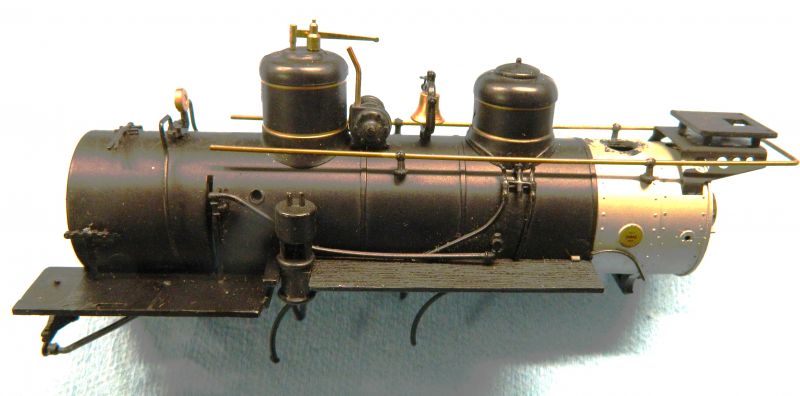
Looking at a diagram of OR&WRR #16 (A Baldwin built in 1901), there a number of things that need changing. The boiler running boards needs moving down so that they level with the cab footplate (at the left). The Westinghouse airpump and pipework for the brakes has to go (the OR&WRR used Eames vacuum brakes powered by an exhaust steam evacuation system in the cab*). The steam dynamo should probably be removed if it has an oil burner headlight, and the bell in front of the steam valve dome should be behind it. The steam valve dome needs moving to the middle boiler ring. The domes are the wrong type and need replacing.The headlight, an electric one currently removed, needs replacing with a much larger oil burner. A new brass chimney would be better than the Bachmann offering.
Tender modifications.
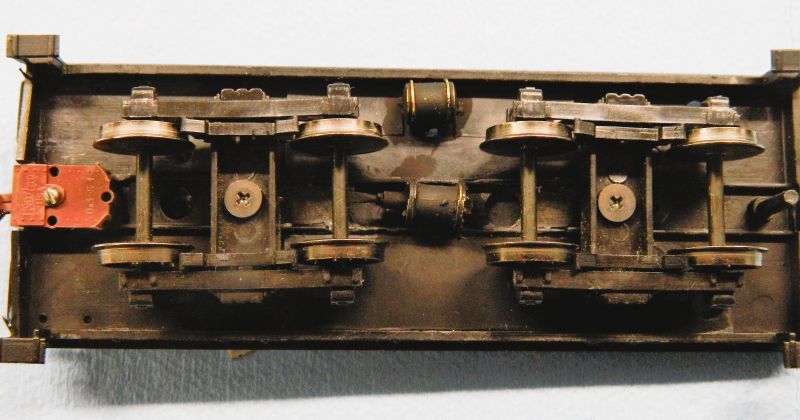
Most of the work is underneath. There are no electrical pickups, some will need adding, and the trucks (bogies) need replacing with 2-spring, not 3-spring, ones. No pipe work, so that needs addressing. The two airtanks also need removing. The orange object on the left is a Bachmann Kadee-type coupler. The OR&WRR was using link and pin couplers in 1912 so that goes.
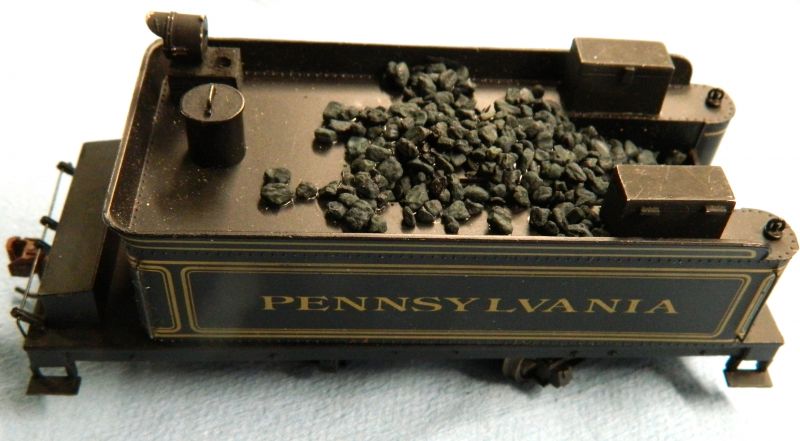
Top side the only things that needs addressing are the reversing lamp I added, the steps, which should have 2, not 1, rungs, and the nearest tool box which should have a peaked, not flat lid. Bit more coal would not come amiss either.
Baldwin works plate.
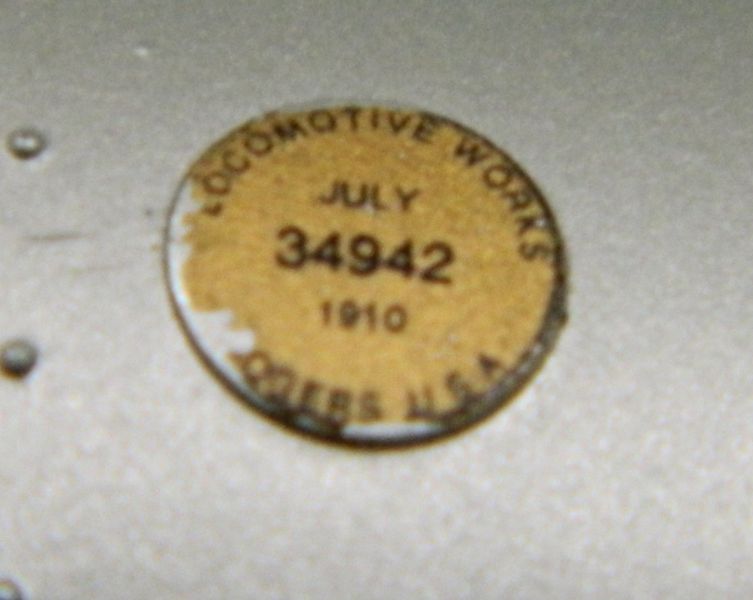
The works number and date are incorrect on the builders plates for the OR&WRR #16. It should be 18844 and dated 1901. Minor point, but the plates are readable without magnification.
Time to get the bits ordered, and do some butchery. If I get it wrong replacement body shells and tender shells are available from Bachmann.
Nigel
*An Eames vacuum brake-equipped Baldwin 4-4-0 came to England for evaluation in 1881 and was bought by the GNR, where it ran for a number of years. They must have liked Baldwin products, because they ordered 20 0-6-0 tender locomotives in 1900.
©Nigel C. Phillips
Posted
Full Member
I'm not surprised the GNR bought some Baldwins - they're nice looking locos and probably strong enough to pull a decent load.
'Petermac
Posted
Full Member
The OR&WRR had a diverse range of steam locomotives, 2-6-0, 4-6-0, 2-8-0, and 4-4-0. There was also a couple of standard gauge ones that ran on dual gauge track - 4-4-0 and 0-6-0. Only one of the seven 2-6-0 locomotives was a Baldwin - #16, the rest came from the Brooks or the Porter locomotive works. Most of the locomotives were bought second- or third-hand from other narrow gauge lines that closed in the 1900s. Details of the Baldwin 2-6-0 should be in the Southern Methodist University DeGolyer Library (it was originally ordered by the United Collieries of Pennsylvania as their #5). For a Brooks or Porter I'll be relying on photographs and wishful thinking as records of their builds are difficult to locate. The 2-8-0 was a Baldwin, as were several of the 4-4-0s. Again, build details should be in the library. If I'm lucky there will even be erecting diagrams.
For some reason the OR&WRR went for the Eames vacuum braking system, cheaper and less complicated compared to the Westinghouse system, but nowhere as effective.
The OR&WRR did not convert to electric headlights until 1921, so it's definitely an oil burner and no steam dynamo for 1912. As usual, Bachmann try and cover as many changes in a locomotives life as possible.
Nigel
 Last edit: by BCDR
Last edit: by BCDR
©Nigel C. Phillips
Posted
Full Member
After some rather frustrating research, I found the original specifications for the OR&WRR #16, built in 1901 for the United Collieries as their #5 (Collection of Baldwin Locomotive Works records 1856-1956, DeGolyer Library, Southern Methodist University). Sadly no drawings of this locomotive on file at the library. In 1901 the company was actually called the Burnham, Williams & Company, so the builders work plate will definitely need changing.
Some interesting information taken from the record:
1. The pilot (pony) truck and tender had 26" diameter spoked wheels. Most of us are used to seeing North American locomotives with solid wheels, but spoked wheels were common in the early 20th. century. Previous experience tells me UK outline OO scale spoked wheels can often be substituted.
2. The driving wheels were 40" in diameter, had a 3" thick tire, and were flanged on the front and back drivers, plain on the middle drivers to allow better running around tight curves. Not what I wanted to find! Either replace, get rid of the flange on the lathe, or ignore. Probably the latter, as replacements wheel sets are no longer available.
3. The boiler had 210 tubes, had a working pressure of 160lbs, and the tractive effort was 15,360lbs. That compares very well with a full size Mogul such as a GWR 43xx, which has a tractive effort of 25,670lbs.
4. The locomotive was guaranteed to haul 100 short tons (2000lbs/ton) on straight track with a 0.4% gradient.
5. The tender underframe was wood, as was the pony truck frame.
6. It was built to a 3 foot gauge, and had 5/8" play on the wheels to allow for less than ideal narrow gauge track and widening of the gauge on curves.
7. The engine and tender were both braked, as built with the Westinghouse air system. This would later be changed by the OR&WRR to the Eames system.
The major dimensions (boiler diameter and length, wheel diameters, dome diameters) are also stated, Interestingly no dimensions for the cab or tender. I'll be checking the Bachmann model dimensions against the record. I suspect the cab may need changing, for a more realistic wood-looking one. Banta Works do one, and I would imagine Precision Scale would have one. More research.
Nigel
P.S. I was going to show a screen shot of the works record, but then got thinking about potential copyright and publication issues. Copyright I doubt is an issue, the order book is 121 years old, but I'll see if I can get permission from the SMU. I also found a photograph of #5 when built as well as some published drawings, again permission beforehand is better.
 Last edit: by BCDR
Last edit: by BCDR
©Nigel C. Phillips
Posted
Full Member
I took some measurements of the Bachmann Mogul, and compared them with the Baldwin records for the OR&WRR #16 (ex United Collieries). Not too bad:
Boiler diameter:1.4% over-scale
Steam dome: 11.7% over-scale.
Sand dome: 7% over-scale.
Pilot and tender wheels: 6% under-scale.
Engine drivers: 7% under-scale.
Cylinder diameter and length: 14% over-scale for the diameter, 20% under-scale for the length.
So far not so bad. Now comes the reality. The driver wheelbase (axle to axle) is 14% under-scale, but the body from the front of the cab to the smoke box is a whopping 28% under-scale. The Bachmann On30 Mogul locomotive is a much shorter beast compared to the 1/4"to the foot (1:48) drawing by Edward Cass of #16 that I found in the Narrow Gauge and Short Line Gazette (Mar/Apr 2008). Same goes for the tender, which is around 10% shorter all round, and also for the cab, which is not long- or high enough. There are some issues such as the brake vacuum reservoirs (I have found some Eame's ones in 1:48 :thumbs), but it's the difference in length that is a real surprise ( :shock:).
So what prototype did Bachmann base their model on? Some online research identifies the Colorado and Southern Railroad Mogul #22, which Bachmann seem to have modeled quite accurately. Built by Baldwin, but a much shorter locomotive all round when compared to #16.
I can live with the slightly shorter driver wheelbase and the tender dimensions, but a body which is nearly 30% too short? Nooo…Some major butchery of the body is going to be required. More than I envisioned, but an interesting challenge. This now means I can locate the DCC decoder in the cab, and the speaker in the body. Cuts down the wires to and from the tender. A silver lining indeed. Might have to get another body shell though. Fingers crossed.
Nigel
©Nigel C. Phillips
Posted
Full Member
'Petermac
Posted
Full Member
Hi Nigel,Hi All,
…………………………………………………………..
I can live with the slightly shorter driver wheelbase and the tender dimensions, but a body which is nearly 30% too short? Nooo…Some major butchery of the body is going to be required. More than I envisioned, but an interesting challenge. This now means I can locate the DCC decoder in the cab, and the speaker in the body. Cuts down the wires to and from the tender. A silver lining indeed. Might have to get another body shell though. Fingers crossed.
Nigel
Some Wonderland of a project you've gotten yourself into here. It will make for some challenging times.
Reading your progress so far reminded me of these two quotes:
"The rabbit-hole went straight on like a tunnel for some way, and then dipped suddenly down"….
`Curiouser and curiouser!' cried Alice
Enjoy the exploration,
Colin
Posted
Full Member
"C&S #21 and #22 were Brooks moguls in name only. In the 1890s, they were re-built with new straight boilers, new frames, new drivers, new cabs, new domes, new stacks, new cylinders (note that #21 and #22 don't say "Brooks" on the cylinder casting after the rebuilds), Items such as the bell and whistle might have been original."
(https://www.steamlocomotive.com/locobase.php?country=USA&wheel=2-6-0&railroad=cs#7682).
And Bachmann stuck Baldwin plates on the model.
All is not lost however. Turns out that if I use the firebox and boiler as the longer boiler (same diameter fortunately) and move it along the chassis, all I need is a new firebox in the cab, which will be pretty much empty (a simple cut and shut). Plenty of room for the decoder and a speaker. And it looks like there is room for a sugar-cube speaker at the front where the original smoke generator was located (or there will be after I take the Dremel and the big file to it). Keeping everything in the locomotive avoids a lot of wires going to and from the tender, and gets the chuff where it is should be - at the front. Probably better if I rewired the pickups so they came up at the back rather than the front of the keeper plate.
One obvious (in retrospect) thing that I checked was whether the scale drawing in the NG&SLG was accurate. It's more 1:46 than 1:48, slightly over-scale (4%), which I'll adjust when I print it out. Doesn't explain the long boiler.
The pistons need moving forward a bit, and the motion rods or the piston rods may need lengthening. The pony truck needs moving forward as well. The cab is pretty simple, bash the old one to the new dimensions, or build from scratch using black styrene (probably the easiest way). The cab on the model is meant to represent a later steel one, it really should be wood. It seems the cabs on the OR&WRR were replaced quite frequently due to the frequent derailments and roll-overs, or to fires, and not always to what was originally there. Modeler's license!
Nothing new in any of this, so I should be able to have a good representation of the OR&WRR #16. The bonus is of course that the Bachmann model will serve very well as a shorter Brooks-built Mogul, and if all goes well a lengthened body will accommodate a 4-wheel truck at the front to give a fair representation of a 10-wheeler. The 4-4-0 American will have to take a different route.
These models go on eBay as NOS or S/H for anywhere between $45-$75. Good value for what is an O-scale locomotive.They're used in the Bachmann Hawthorne Village range - anything from Budweiser beer through Christmas to Disney. Most only see a few weeks running around the Christmas tree for 3-5 years.
Nigel
©Nigel C. Phillips
Posted
Full Member
Demolition derby today, it now looks like a locomotive in the shops for a major overhaul. It all came apart surprisingly smoothly. Good news is that the piston rod is long enough to allow the pistons to be moved forward. The front truck/bogie now was spoked wheels, and needs moving forward to accommodate the longer smoke box length. The cab will need moving back (not as much as I first thought, and some height and length added. The smoke box will need extending. Boiler rings will need removing and sanding, and the various holes filled in. I'm trying to preserve the snap lugs at the ends of the body that snap on the chassis, looks to be a go. Next job will be to remove the backhead and the front half of the smoke box, do some body lengthening, and fill in the holes.
I have an eye on a couple of 2-6-0 offerings on eBay, a 4-6-0 would be nice, as well as a Brooks mogul.
Nigel
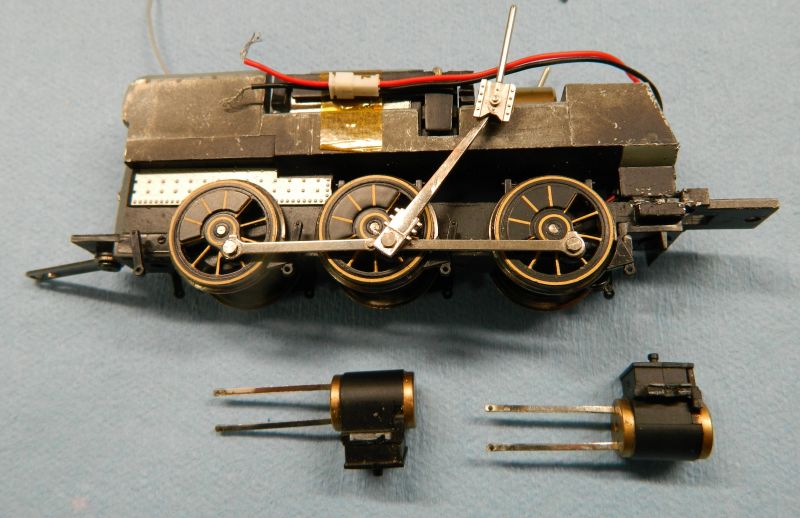
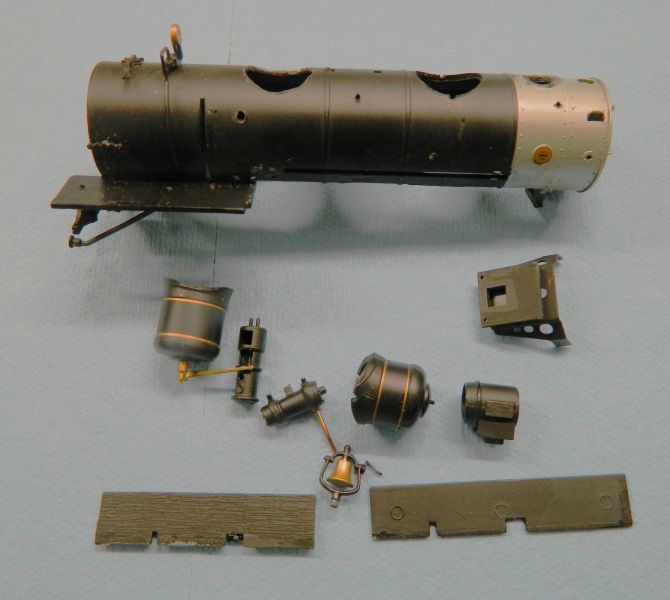
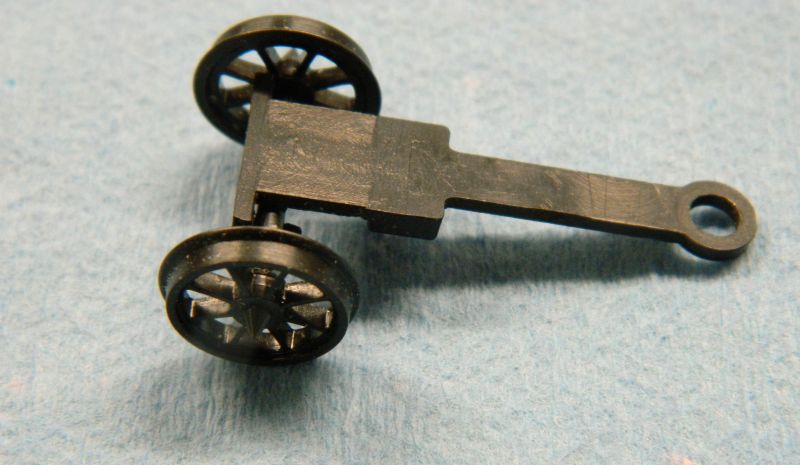
©Nigel C. Phillips
Posted
Full Member
The work required on the "Bud" is minimal, basically removal of the air brake components, relocation of the headlight, fill any holes, strip and repaint in black and aluminum. Others have stripped the paint off these models using 91% IPA without damage to the plastic, so I will give it a go.
I have located the parts required to convert the original Bachmann 2-6-0 so it looks more like a Baldwin 2-6-0 - cylinder saddle/cross-heads, domes, boiler extension, chimney, cab,all in brass castings.
Nigel
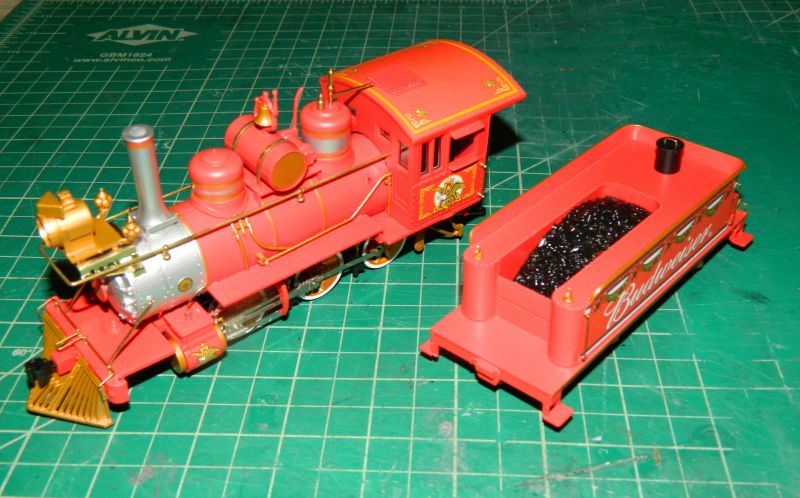
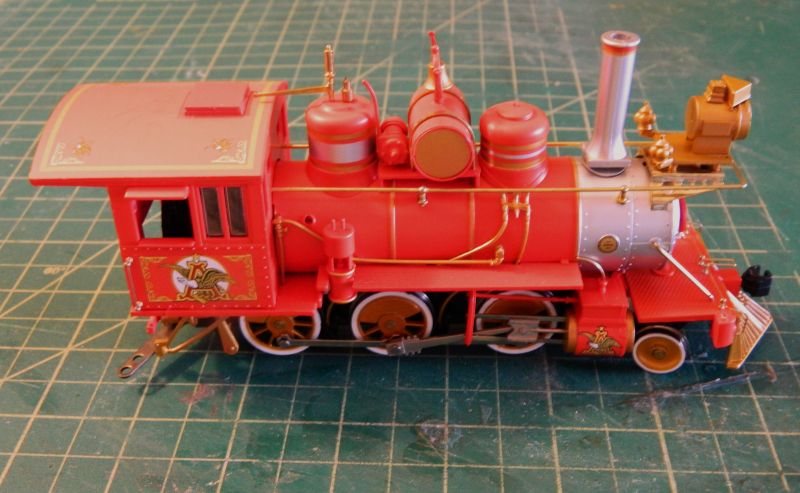
©Nigel C. Phillips
1 guest and 0 members have just viewed this.

